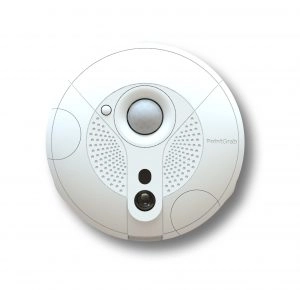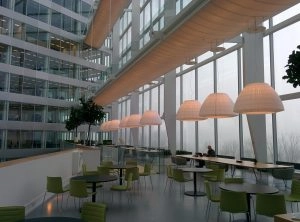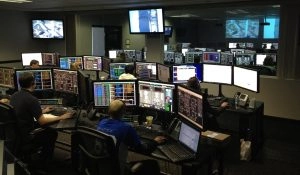HOW SMART BUILDINGS LEAD TO SMARTER BUSINESSES WITH ROEE PELED OF POINTGRAB
MarketScale’s own Sean Heath sat down and spoke with Roee Peled, the Sales Executive for PointGrab, a company that provides some of the most advanced facility management sensing solutions for workspace optimization across many industries. They discuss the growth of sensor technology and the wealth of data that it provides, how that information can dramatically alter the efficiency of building usage, and how the design of intelligent buildings is just in the beginning stages.
Sean Heath: You work in a company that has over 30 million consumer electronic devices installed with your HMI Software. That’s a different type of communication. Do you find that there are certain commonalities or are we striving to reach certain levels of equality in HMI being compared to human to human?
Roee Peled: Well, actually the 30 million installations was with a previous platform that we had which has to do with gesture recognition for electronic consumer devices. It was HMI like you mentioned, but it was also human-to-human interaction because you could customize it to gaming and to other applications and fields. But also what we are doing today with the technology which is based around computer vision and deep-learning algorithms, with our current platform around smart sensing and smart buildings, we’re looking at the use cases such as the well-being and the comfort of the employee as well as the collaboration of the employees with each other and how we can improve that and the whole environment in the office space. So certainly also in this point, there is a lot to do with human-to-human interaction.

Sean Heath: Tell me a little bit about the overall change that intelligent sensors can have in the way that we use and exist in our buildings on a daily basis.
Roee Peled: Well, it’s a lot to do with how buildings are changing and how the way buildings are used is changing. Probably as you know and as you have experienced in the past, it was more around the office space and then things got to open up a little bit and people started using cubicles or other more open space architectures. But what we’re seeing in the last few years and starting more and more to expand is the use of flexible and agile workspaces where you don’t actually have a dedicated desk or a dedicated space but rather you come in the morning and you find an empty desk to work in and then you go to a meeting. And when you finish the meeting, you find another empty desk and so on.

So the whole office space is becoming more flexible and agile. And in order to manage that more efficiently and also to provide the employee with some kind of tools or capabilities to use that more efficiently and to improve the way that he feels about the office space, you need different platforms starting with data-enabling platforms such as the sensing solution that we provide in order to enable such a solution and such a workspace environment.
Sean Heath: Could we say this is similar to the memory settings on a seat in your car that the building learns the way that I like to work and then it is able to transfer those settings or those parameters to whichever workspace I go to?
Roee Peled:So it’s a combination of that and an additional way of thinking. So usually most of our customers before they move into a flexible environment, they would start off with a kind of utilization study or occupancy study to see how their current space is being used. And based on the data that they collect, they can then analyze it and plan the space more efficiently. Now this is relying more on historical data or statistical data that you collected over time.
With regards to the memory that you mentioned, it’s more relating to real-time applications. So you will have a kind of application where in the morning you will select in which building you would like to work in and in which floor either based on your preference or on the availability of the resource.
Sean Heath:What’s really interesting about that concept to me is that normally when we think about business applications, we think about the way they affect the humans that use those. In a way, this also affects the way the building behaves almost as if it takes on a personality which gives them an incredible amount of flexibility, I would think, to the way we design those buildings in the first place.
Roee Peled:Exactly. And again, this is part of the combination between historical statistical data and real-time data. So based on the historical data that you collect, you can actually plan your existing building or a future building that you’re about to construct. You can plan it more efficiently and customize it more to your exact needs. And at the same time, keep a very high level of flexibility and agility with regards to the resources and the services that you provide to the employees.

Sean Heath: So it’s a pretty all-encompassing approach that CogniPoint presents. Tell me about a use case or two that surprised you, that when a customer said, “Hey, we like to be able to do this,” you originally thought, “Huh, we never tried to do that.” What suggestions or request have surprised you?
Roee Peled: So there are a lot of additional verticals where this can be applied for and currently we’re in a stage of exploring and expanding to those verticals. Several examples I can give is for example in the medical space, so placing these sensors in hospitals, in inspection rooms, in patient rooms to see the occupancy. You can take it one level further and customize the algorithm to identify for example whether a person has fallen off his bed, whether he’s sitting down or standing up or lying down. You can take this to universities, to the education sector, see how classrooms are being used, whether a certain course leaves up to the occupancy levels that it initially expected. You can take it into the retail sector.
So for example to see or to count how many people walked in and out of a store and then compare it to the income or the revenue on that day or on that month. You can also use it to see or to create what we call heat maps to see where people tend to concentrate whether it’s on a specific aisle or next to a specific product. And like you mentioned, you can take it to the hotel sector to see how many people are actually going into specific rooms.
Roee Peled: And again, I think that the idea here is to rather than look at the building, rather than a block structure with cement, look at it as a kind of dynamic area where you interact with the building the building interacts with you. And as a result of that, it can actually give you a kind of a feeling or a comfort level that you wouldn’t get if that building wasn’t smart.
For the latest news, videos, and podcasts in the Building Management Industry, be sure to subscribe to our industry publication.
Follow us on social media for the latest updates in B2B!
Twitter – @BuildingMKSL
Facebook – facebook.com/marketscale
LinkedIn – linkedin.com/company/marketscale









